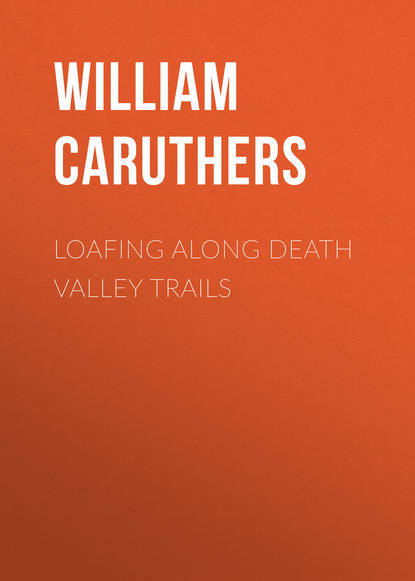По всем вопросам обращайтесь на: info@litportal.ru
(©) 2003-2024.
✖
Loafing Along Death Valley Trails
Настройки чтения
Размер шрифта
Высота строк
Поля
The next morning Rosie and Aaron bade the guest good luck and goodbye and he went into the horizon without even leaving his name. Then Rosie turned to Aaron: “Maybe,” she said … “maybe that white stuff we see that time below Furnace Creek – maybe that is borax.”
“Might be,” Aaron answered.
“Why don’t we go see?” Rosie asked. “Maybe some Big Horn sheep – ” Rosie knew her man and Aaron Winters got his rifle and Rosie packed the sow-belly and beans.
It was a long, gruelling trip down into the valley under a Death Valley sun but hope sustained them. They made their camp at Furnace Creek, then Rosie led Aaron over the flats she remembered. She scooped up some of the white stuff that looked like cotton balls while Aaron prepared for the test. Then the brief, uncertain moment when the white stuff touched the flame. Tensely they watched, Aaron grimly curious rather than hopeful; Rosie with pounding heart and lips whispering a prayer.
Then, miracle of miracles – the green flame. They looked excitedly into each other’s eyes, each unable to believe. In that moment, Rosie, always devout, lifted her eyes to heaven and thanked her God. Neither had any idea of the worth of their find. Vaguely they knew it meant spending money. A new what-not for Rosie’s mantel. Perhaps pine boards to cover the hovel’s dirt floor; maybe a few pieces of golden oak furniture; a rifle with greater range than Aaron’s old one; silk or satin to make a dress for Rosie.
“Writers have had to draw on their imagination for what happened,” a descendant of the Winters once told me. “They say Uncle Aaron exclaimed, ‘Rosie, she burns green!’ or ‘Rosie, we’re rich!’ but Aunt Rosie said they were so excited they couldn’t remember, but she knew what they did! They went over to the ditch that Bellerin’ Teck had dug to water the ranch and in its warm water soaked their bunioned feet.”
Returning to Ash Meadows they faced the problem of what to do with the “white stuff.” Unlike gold, it couldn’t be sold on sight, because it was a new industry, and little was known about its handling. Finally Aaron learned that a rich merchant in San Francisco, named Coleman was interested in borax in a small way and lost no time in sending samples to Coleman.
W. T. Coleman was a Kentucky aristocrat who had come to California during the gold rush and attained both fortune and the affection of the people of the state. He had been chosen leader of the famed Vigilantes, who had rescued San Francisco from a gang of the lawless as tough as the world ever saw.
Actually Coleman’s interest in borax was a minor incident in the handling of his large fortune and his passionate devotion to the development of his adopted state. For that reason alone, Coleman had become interested in the small deposits of borax discovered by Francis Smith, first at Columbus Marsh.
Smith had been a prospector before coming to California, wandering all over western country, looking for gold and silver. He was one of those who had heard that borax was worth keeping in mind.
Reaching Nevada and needing a grubstake, he began to cut wood to supply mines around Columbus, Aurora, and Candelaria. On Teel’s Marsh he found a large growth of mesquite, built a shack and claimed all the wood and the site as his own. Upon a portion of it, some Mexicans had cut and corded some of the wood and Smith refused to let them haul it off. They left grudgingly and with threats to return. The Mexicans, of course, had as much right to the wood as Smith.
Sensing trouble and having no weapons at his camp, he went twelve miles to borrow a rifle. But there were no cartridges and he had to ride sixty miles over the mountains to Aurora where he found only four. Returning to his shack, he found the Mexicans had also returned with reinforcements. Twenty-four were now at work and their mood was murderous. Smith had a companion whose courage he didn’t trust and ordered him to go out in the brush and keep out of the way.
The Mexicans told Smith they were going to take the wood. Smith warned that he would kill the first man who touched the pile. With only four cartridges to kill 20 men, it was obviously a bluff. One of the Mexicans went to the pile and picked up a stick. Smith put his rifle to his shoulder and ordered the fellow to drop it. Unafraid and still holding the stick the Mexican said: “You may kill me, but my friends will kill you. Put your rifle down and we will talk it over.”
They had cut additional wood during his absence and demanded that they be permitted to take all the wood they had cut. Smith consented and when the Mexicans had gone he staked out the marsh as a mining claim – which led to the connection with Coleman.
Upon receipt of Winters’ letter, Coleman forwarded it to Smith and asked him to investigate the Winters claim. Smith’s report was enthusiastic. Coleman then sent two capable men, William Robertson and Rudolph Neuenschwander to look over the Winters discovery, with credentials to buy. Again Rosie and Aaron Winters heard the flutter of angel wings at the hovel door. This time the angels left $20,000. Rarely in this world has buyer bought so much for so little, but to Aaron and Rosie Winters it was all the money in the world.
Despite the troubles of operating in a place so remote from market and with problems of a product about which too little was known, borax was soon adding $100,000 a year to Coleman’s already fabulous fortune.
Francis M. (Borax) Smith was put in charge of operations under the firm name of Coleman and Smith.
Freed from the sordid squalor of the Ash Meadows hovel, the Winters bought the Pahrump Ranch, a landmark of Pahrump Valley, and settled down to watch the world go by.
Thus began the Pacific Coast Borax Company, one of the world’s outstanding corporations. Later Smith was to become president of the Pacific Coast Borax Company and later still, he was to head a three hundred million dollar corporation for the development of the San Francisco and Oakland areas and then face bankruptcy and ruin.
Overlooking the site where Rosie and Aaron made the discovery, now stands the magnificent Furnace Creek Inn.
One day while sitting on the hotel terrace, I noticed a plane discharge a group of the Company’s English owners and their guests. Meticulously dressed, they paid scant attention to the desolation about and hastened to the cooling refuge of their caravansary. At dinner they sat down to buttered mignon and as they talked casually of the races at Ascot and the ball at Buckingham Palace, I looked out over that whitehot slab of hell and thought of Rosie and Aaron Winters trudging with calloused feet behind a burro – their dinner, sow-belly and beans.
Chapter IV
John Searles and His Lake of Ooze
Actually the first discovery of borax in Death Valley was made by Isadore Daunet in 1875, five years before Winters’ discovery. Daunet had left Panamint City when it was apparent that town was through forever and with six of his friends was en route to new diggings in Arizona.
He was a seasoned, hardy adventurer and risked a short cut across Death Valley in mid-summer. Running out of water, his party killed a burro, drank its blood; but the deadly heat beat them down. Indians came across one of the thirst-crazed men and learned that Daunet and others were somewhere about. They found Daunet and two companions. The others perished.
When Daunet heard of the Winters sale five years later, like Rosie Winters he remembered the white stuff about the water, to which the Indians had taken him. He hurried back and in 1880 filed upon mining claims amounting to 260 acres. He started at once a refining plant which he called Eagle Borax Works and began operating one year before Old Harmony began to boil borax in 1881. Daunet’s product however, was of inferior grade and unprofitable and work was soon abandoned. The unpredictable happened and dark days fell upon borax and William T. Coleman.
In 1888 the advocates of free trade had a field day when the bill authored by Roger Q. Mills of Texas became the law of the land and borax went on the free list. The empire of Coleman tumbled in a financial scare – attributed by Coleman to a banker who had falsely undervalued Coleman’s assets after a report by a borax expert who betrayed him. “My assets,” wrote Coleman, “were $4,400,000. My debts $2,000,000.” No person but Coleman lost a penny.
But Borax Smith was never one to surrender without a fight and organized the Pacific Coast Borax Company to take over the property and the success of that company justifies the faith and the integrity of Coleman.
Marketing the borax presented a problem in transportation even more difficult than it did in Tibet. At first it was scraped from the flat surface of the valley where it looked like alkali. It was later discovered in ledge form in the foothills of the Funeral Mountains. The sight of this discovery was called Monte Blanco – now almost a forgotten name.
The borax was boiled in tanks and after crystallization was hauled by mule team across one hundred and sixty-five miles of mountainous desert at a pace of fifteen miles per day – if there were no accidents – or an average of twenty days for the round trip. The summer temperatures in the cooler hours of the night were 112 degrees; in the day, 120 to 134 (the highest ever recorded). There were only four water holes on the route. Hence, water had to be hauled for the team.
The borax was hauled to Daggett and Mojave and thence shipped to Alameda, California, to be refined. Charles Bennett, a rancher from Pahrump Valley, was among the first to contract the hauling of the raw product.
In 1883 J. W. S. Perry, superintendent of the borax company, decided the company should own its freighting service and under his direction the famous 20 mule team borax wagons with the enormous wheels were designed. Orders were given for ten wagons. Each weighed 7800 pounds. Two of these wagons formed a train, the load being 40,000 pounds. To the second wagon was attached a smaller one with a tank holding 1200 gallons of water.
“I’d leave around midnight,” Ed Stiles said. “Generally 110 or 112 degrees.”
The first hauls of these wagons were to Mojave, with overnight stations every sixteen miles. Thirty days were required for the round trip.
In the Eighties a prospector in the then booming Calico Mountains, between Barstow and Yermo discovered an ore that puzzled him. He showed it to others and though the bustling town of Calico was filled with miners from all parts of the world, none could identify it. Under the blow torch the crystalline surface crumbled. Out of curiosity he had it assayed. It proved to be calcium borate and was the world’s first knowledge of borax in that form. Previously it had been found in the form of “cotton ball.” The Pacific Coast Borax Company acquired the deposits; named the ore Colemanite in honor of W. T. Coleman.
Operations in Death Valley were suspended and transferred to the new deposit, which saved a ten to fifteen days’ haul besides providing a superior product. The deposit was exhausted however, in the early part of the century when Colemanite was discovered in the Black Mountains and the first mine – the Lila C. began operations.
It is a bit ironical that during the depression of the Thirties, two prospectors who neither knew nor cared anything about borax were poking around Kramer in relatively flat country in sight of the paved highway between Barstow and Mojave when they found what is believed to be the world’s largest deposit of borax.
It was a good time for bargain hunters and was acquired by the Pacific Coast Borax Company and there in a town named Boron, all its borax is now produced.
Even before Aaron Winters or Isadore Daunet, John Searles was shipping borax out of Death Valley country. With his brother Dennis, member of the George party of 1861, Searles had returned and was developing gold and silver claims in the Slate Range overlooking a slimy marsh. They had a mill ready for operation when the Indians, then making war on the whites of Inyo county destroyed it with fire. A man of outstanding courage, Searles remained to recuperate his losses. He had read about the Trona deposits first found in the Nile Valley and was reminded of it when he put some of the water from the marsh in a vessel to boil and use for drinking. Later he noticed the formation of crystals and then suspecting borax he went to San Francisco with samples and sought backing. He found a promoter who after examining the samples, told him, “If the claims are what these samples indicate, I can get all the money you need…”
An analysis was made showing borax.
“But where is this stuff located?”
Searles told him as definitely as he could. He was invited to remain in San Francisco while a company could be organized. “It will take but a few days…”
Searles explained that he hadn’t filed on the ground and preferred to go back and protect the claim.
The suave promoter brushed his excuse aside. “Little chance of anybody’s going into that God forsaken hole.” He called an associate. “Take Mr. Searles in charge and show him San Francisco…”
Not a rounder, Searles bored quickly with night life. His funds ran low. He asked the loan of $25.
“Certainly…” His host stepped into an adjacent office, returning after a moment to say the cashier was out but that he had left instructions to give Searles whatever he wished.
Searles made trip after trip to the cashier’s office but never found him in and becoming suspicious, he pawned his watch and hurried home, arriving at midnight four days later.
The next morning a stranger came and something about his attire, his equipment, and his explanation of his presence didn’t ring true and Searles was wary even before the fellow, believing that Searles was still in San Francisco announced that he had been sent to find a man named Searles to look over some borax claims. “Do you know where they are?”
Searles thought quickly. He had not as yet located his monuments nor filed a notice. He pointed down the valley. “They’re about 20 miles ahead…”
The fellow went on his way and before he was out of sight, Searles was staking out the marsh and with one of the most colorful of Death Valley characters, Salty Bill Parkinson, began operations in 1872. Incorporated under the name of San Bernardino Borax Company, the business grew and was later sold to Borax Smith’s Pacific Coast Borax Company.







